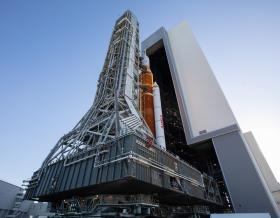
VIPER 3D model (Credit: NASA)
As part of the Artemis program, NASA is developing its first mobile rover to explore the southern pole of the moon in search of ice and other resources on and below the lunar surface. Data from the Volatiles Investigating Polar Exploration Rover, or VIPER, will help the agency map frozen water resources at the edge of Shackleton Crater that could one day be harvested for long-term human exploration on the moon.
The design of the golf-cart-sized rover calls for using solar battery powered headlights to aid in exploring the permanently shadowed regions of the moon. These areas haven’t seen sunlight in billions of years and are some of the coldest spots in the solar system. Running on solar power, VIPER will need to maneuver between extremes of light and dark at the lunar South Pole. Once on the moon, the rover will explore lunar craters using a specialized set of wheels and suspension system to cover a variety of inclines and soil types. Jacobs engineers at Johnson Space Center directly support the NASA team in VIPER systems engineering, integration and testing, as well as design of structural elements, motor controllers and lights.

VIPER mobility testbed, an engineering model created to evaluate the rover’s mobility system. (Credit: NASA)
VIPER has evolved to increase its science capabilities, enabling more data collection at the lunar surface. VIPER will carry four instruments, including the Regolith and Ice Drill for Exploring New Terrains (TRIDENT) hammer drill, the Mass Spectrometer Observing Lunar Operations (MSolo) instrument, the Near Infrared Volatiles Spectrometer System (NIRVSS) and the Neutron Spectrometer System (NSS). Earlier versions of these instruments will be tested on the lunar surface ahead of the VIPER mission, allowing the team to reduce risk and test instrument performance data.
“The data received from VIPER has the potential to aid lunar scientists in determining precise locations and concentrations of ice on the moon,” says Jacobs Critical Mission Solutions VP and GM for NASA Johnson Space Center Joy Kelly. “This is a strong example of how robotic science missions and human exploration go hand in hand, and why both approaches are uniquely valuable as we prepare to establish a long-term sustainable presence on the moon.”
Throughout the Artemis program, NASA will send robots and humans to explore more of the moon than ever before. When astronauts return to the lunar surface for the first time since 1972, they will follow in VIPER’s wheel prints and land at the lunar South Pole. That mission will include landing the first woman and first person of color on the moon, paving the way for sustainable lunar exploration missions with crew.
For more on how Jacobs is redefining what’s possible, from launch to flight to splash down, visit www.jacobs.com/insights/space-exploration.












2c4e.jpg)


















_0ac2b.jpg)









2747.png)














